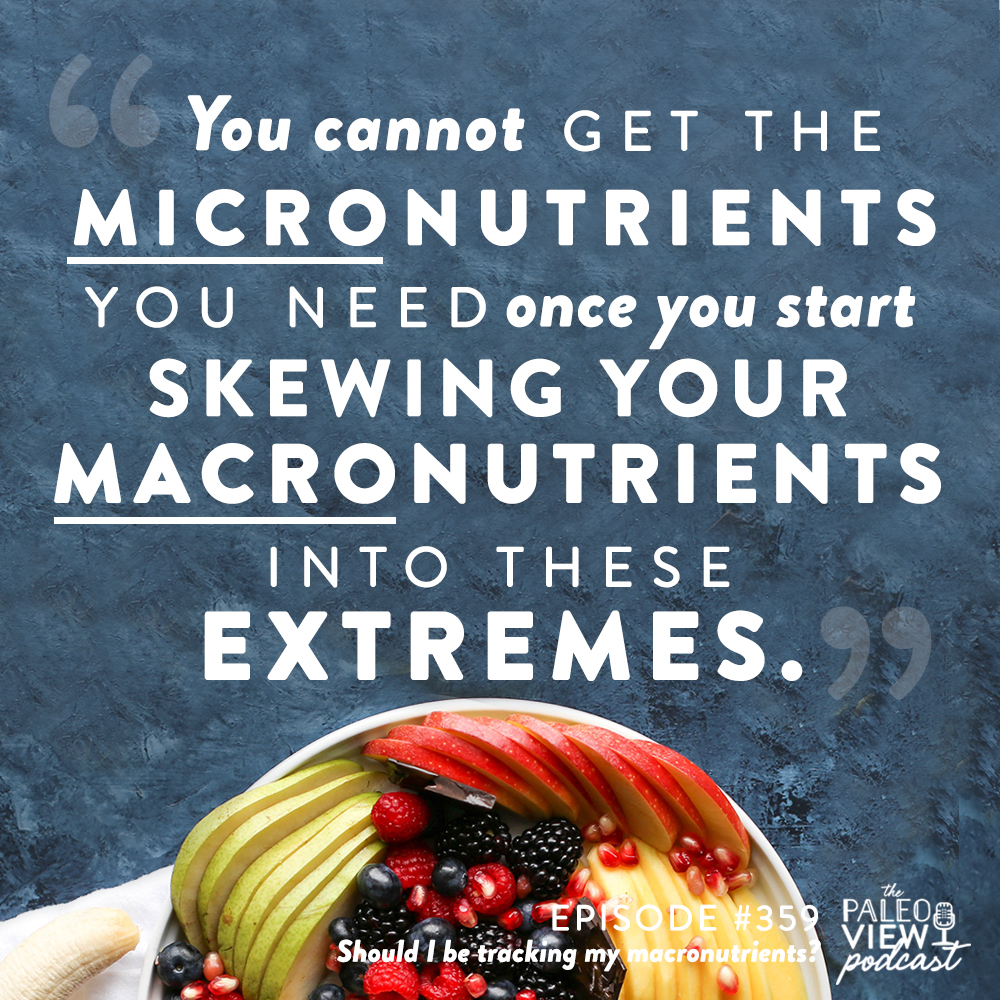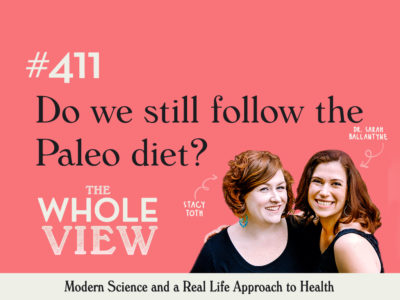On this week’s episode, Stacy and Sarah discuss macronutrients and the role that they play in both achieving your health goals and maintaining those goals. Is tracking your macronutrients an important healthy habit? What are the “ideal numbers” when you are tracking? And when do micronutrients come into play? All of this and more on episode 359. Enjoy!
If you enjoy the show, please review it on iTunes!
The Paleo View (TPV), Episode 359: Should I be tracking my macronutrients?
-
-
(0:41) Welcome
- Welcome back to The Paleo View!
- Stacy has no idea what day it is
- The Toth/McCarry crew is currently in Salt Lake City and will soon be heading on to Denver
- They have a whole lot of country left to explore, and lots of events on the calendar
- Stacy shared details on their zigzag travel plans
- Sarah sent out a warm Happy Canada Day to all the Candian listeners! And a Happy Independence Day to the American listeners!
- Special thank you to this week’s sponsor, Wild Zora
- They are not just sponsoring this show but are also fueling Stacy’s family as they are traveling across the country
- To check them out visit: wildzora.com/thepaleoview
- Using that link you can get free shipping and 30% off your order
- Wild Zora is jerky that has vegetables incorporated
- Stacy said they are delicious and the texture is perfect
-
(7:15) Macronutrients & Micronutrients
- On this week’s episode, Stacy and Sarah are going to talk about macronutrients
- While this is a little bit of a tangential discussion from the typical micronutrient nerdiness that this show covers, Stacy wanted to dig into this topic
- Macronutrients were something that Stacy did use to track when she was on a lifting schedule because she found that it did help with her performance
- Stacy has noticed that it is common to see foods marketed today towards the keto community
- These foods tend to be macronutrient heavy in one way or another
- Recently on Instagram Stacy saw someone sharing a product with crazy macronutrient ratios
- It was a fat bomb that just didn’t make sense on a macronutrient level
- What concerns Stacy about people going so focused on macros is when all acknowledgment towards balance is ignored
- Sarah has seen in gyms how they promote macro tracking
- At her gym, in particular, they have an ‘Eat Your Macros’ program
- In these instances, you see some people who aren’t nutrient literate hitting their numbers with unhealthy foods/drinks
- At her gym, in particular, they have an ‘Eat Your Macros’ program
- Being overly focused on macronutrients runs into problems when it is not connected to a food quality conversation and a micronutrient conversation
- There is also this other part of this conversation that is happening right now where we are seeing these macronutrient extreme diets
- Examples include:
- Low/zero carb
- Keto
- Low fat
- Carnivore
- Examples include:
- There is also this other part of this conversation that is happening right now where we are seeing these macronutrient extreme diets
- Sarah wants to take this episode to unpack macronutrients a little bit
- What is the difference between macros and micros?
- Macros really just translate to energy
- Macro means big
- It is nutrients that we need from food in big quantities
- Carbohydrates, fat, protein and fiber
- Micro means small
- It is nutrients that we need from food in small quantities
- Vitamins, minerals, phytochemicals, essential amino acids, and essential fatty acids
- Macros really just translate to energy
- The stuff that we need in big quantities translates into energy
- There is also some raw material stuff in macronutrients
- Protein is used to make proteins in our body
- It’s not just making muscle, it is making components of every single cell
- Fat makes up cell membranes
- Our brain is about 60% fat
- Hormones are fat-based molecules
- Protein is used to make proteins in our body
- We use some of these things as building materials and the rest we use as energy to drive chemical reactions
- Fiber is really about feeding our gut microbiome
- There is also some raw material stuff in macronutrients
- Even though we need micronutrients in small quantities, it is quite a challenge to get micronutrient sufficiency
- This is the nutrient density piece that is always be covered on the show
- As soon as you try to get all the micronutrients that your body needs in adequate quantities from whole foods, you are forced into a Paleo or AIP style diet
- This means eating seafood, organ meat, a ton of vegetables, fruit, nuts and seeds, fresh herbs
- This is how you get micronutrient sufficiency
- On this week’s episode, Stacy and Sarah are going to talk about macronutrients
-
(14:27) Our Needs Through the Scientific Lens
- Sarah is going to come at macronutrient guidelines by looking at basic ideas about human anatomy and physiology
- One of the ways to do this is by looking at hunter-gather intakes
- What is the macronutrient range that we see among hunter-gather populations, given that human evolution was often driven by the energy density of our food
- Sarah dug into these studies that have been completed across the world
- How foods are used to correct macronutrient imbalances
- We look at these societies that mimic the diet that we would have had for at least the last few hundred, thousand years of evolution
- These diets don’t have any of the chronic health problems that are associated with industrial, western countries
- We observe the trends and form a hypothesis regarding the macronutrient levels that are likely ideal
- AMDR
- The Food and Nutrition Board of the Institute of Medicine has set Accepted Macronutrient Distribution Ranges (AMDR) for protein, fat, and carbohydrates based on evidence from interventional trials with support of epidemiological evidence that suggests a role in the prevention or increased risk of chronic diseases and based on ensuring sufficient intake of essential nutrients
- Levels of too much or too little are associated with some kind of health problem
- This is completely based on contemporary studies
- AMDR for fat estimated to be 20 to 35% of total energy for adults
- AMDR for protein estimated to be 10 to 35% of total energy for adults
- AMDR for carbohydrates as an estimated 45 to 65 percent of total energy (and below 25 percent from sugars) doesn’t quite align with hunter-gatherer intakes
- The Food and Nutrition Board of the Institute of Medicine has set Accepted Macronutrient Distribution Ranges (AMDR) for protein, fat, and carbohydrates based on evidence from interventional trials with support of epidemiological evidence that suggests a role in the prevention or increased risk of chronic diseases and based on ensuring sufficient intake of essential nutrients
- One of the ways to do this is by looking at hunter-gather intakes
- We can take this information and through the lens of our philosophies on understanding science, we can add some interesting additional things on to that
- We know that higher protein intake is really really important for weight management
- We know that there are some genes where lower fat is really important
- 25% of people have one or more copies of the gene where a diet lower in fat is ideal for their bodies
- We know that with the modern food supply sugars are actually more important to limit than total carbohydrates
- When we start to add in this extra insight by taking in an even bigger picture view of the scientific evidence, we can come up with a macronutrient intake range that sort of fits modern science and hunter-gather intakes
- This will give us a pretty good target with a lot of wiggle room for self-experimentation
- When Sarah looks at all of this data together, here is what she ends up with:
- 20-35% of our total calories coming from fat
- 20-35% of our total calories coming from protein
- 30-60% of our total calories coming from whole food sources of carbohydrates
- This is what Sarah refers to as balanced macronutrients
- This doesn’t mean that every meal needs to be super regimented
- The body seems to respond really well to fluctuations in macronutrients
- Ex: seasonal variability, macro timing throughout the day
- The body seems to respond really well to fluctuations in macronutrients
- These macronutrient ranges don’t look like any of the diet extremes
- To learn more about the challenges that arise from extreme diets, check out Episode 140: The Danger of Ketogenic Diets and Episode 305: Why Insulin Is Important & Awesome!
- Fad diets, where the primary goal is weight loss, are not designed to be healthy
- When we look at macronutrients and we look at them in this way, we are really looking at:
- What is the range where we are going to be able to maintain health?
- And these are the ranges that we end up in
- 30-60% calories from carbohydrates give us a lot of playing room
- When we look at macronutrients and we look at them in this way, we are really looking at:
- Sarah is going to come at macronutrient guidelines by looking at basic ideas about human anatomy and physiology
-
(25:03) The Balancing Act
- What’s curious to Stacy is the idea of this balance of macronutrients
- If you talk to three different people they would tell you three different things about what the ideal is
- Stacy does think it is true that it is an individual thing
- Sarah thinks that what we are learning is that too much or too little of any macronutrient is associated with health problems
- With micronutrients, we know that there is a range that is considered sufficient for most people
- Then there are these extra situations where you might need extra of certain micronutrients
- We also see that kind of variation in macros
- For example, if you are someone who is very active, that increases your protein requirements
- Every diet works to help you lose weight, but most of these diets promote both lean muscle mass loss and fat loss
- Depending on the diet, it can be up to a pound for pound (fat to muscle) loss
- When you lose muscle, you lower your basal metabolic rate
- Preserving lean muscle is really important for preserving metabolism
- If your metabolism tanks than you need lower amounts of calories to keep losing weight
- If you lose weight too quickly, you increase your hunger hormones, which drives appetite
- You have this perfect storm of being hungrier than you would normally be
- Making it harder to maintain your diet
- One of the ways to get around this is to up your protein intake and to incorporate some weight bearing exercise
- Aim for a moderate caloric intake so that you are not losing weight too quickly
- Yes you lose weight more slowly, but it is easier to keep the weight lost off
- Sarah provided more examples of where people will fall within the ranges based on certain attributes and medical conditions
- We have within these ranges people who will do better at the low end or at the high end, and there are so many different situations that will determine where you fall
- We probably are supposed to have seasonal variability as well
- Sarah recommends playing within these ranges
- With micronutrients, we know that there is a range that is considered sufficient for most people
- If we are going to take a micronutrient approach and aim to get enough fiber (which is really critical) and enough protein and balance the plant versus animal food so that we achieve micronutrient sufficiency, it almost forces you into those ideal ranges
- It is incredibly challenging to get enough fiber and not end up with about 40% of your calories from carbohydrates
- Our dense fiber foods, like 3.5 cups sweet potatoes, has 25 grams of fiber
- Which would be the USDA fiber allowance for a woman
- Sarah noted that this probably half of what we actually need
- This is not a ridiculous amount of sweet potato to eat throughout the whole day, which will give you 150 grams of carbohydrates
- You can get the same amount of fiber from 24 cups of spinach
- Which would give you 50 grams of carbohydrates
- Dense sources of fiber are going to work best for most of us
- In order to get enough fiber, it is really tough to do without your total carbohydrates ending in the 200 to 300-gram range
- From a fiber intake perspective, getting enough vegetable matter to get our fiber intake up to where it is supposed to be, that automatically puts us in the higher carbohydrate range
- If you think about your plate being 3/4 vegetables and using some fat to make things tasty, adding some nuts and seeds, and having quality meats; it is almost impossible to not end up in those balanced macronutrient ranges when you start thinking about micronutrients
- This is why you need balanced macros
- You cannot get the micronutrients you need once you start skewing your macronutrients into these extremes
- You are going to miss out on something
- There are micronutrients packaged up with our macronutrients that are really important
- Part of aiming for balanced macronutrients and having a food quality criteria for choosing foods is achieving micronutrient sufficiency
- Stacy is shocked that it came back around to micronutrients
- It makes sense that athletes, for example, are turning to products that are targeted to increasing whatever macro they are focused on and not necessarily the micros associated with it
- Stacy loves the way Sarah framed her explanation
- That if you think for a minute of just the basic necessity of fiber and the micronutrients you need, and then from there consider the macro piece, you will be in the right headspace
- It is a struggle overall to achieve balance because there are so many factors that go into it
- However, when we consider the goal and where we are coming from, we are able to make decisions based on long-term health goals
- One of the things that Sarah wants to emphasize is that this is a learning curve
- Sarah will do a 3-day food diary once a quarter
- She uses the Cronometer app
- With this data, she is checking in on her fiber, protein, and her micronutrients
- She lets fat and carbs land where they may because they are going to land in healthy zones if she is getting enough fiber and enough protein
- Sarah will do a 3-day food diary once a quarter
- Sarah thinks that for most people fiber is where people are most challenged when getting their macronutrients in balance
- Protein is typically second
- It takes a few days, maybe a week, of measuring foods and looking at databases for nutrition information to get a sense for where you are at and where you can fine-tune to hit your numbers
- Find the foods that fill in the gaps for you
- Figure out what your place looks like
- Then you can wean off the measuring and logging, and simply execute what you found out about your ideal plate makeup
- And from there you can check in every once in a while to make sure you are on track
- Food journaling is a phenomenal tool for weight loss
- Awareness around what you are eating is really important for the behavioral modification of weight loss
- However, Stacy noted that for those with a history of disordered eating it can be problematic
- Be mindful of this when identifying how best to check your macro and micro levels
- Stacy shared her experience with being respectful of the emotional pieces associated with tracking
- It doesn’t need to be an overwhelming experience if we come from the perspective of what is my intent, what am I trying to achieve, is this food choice the best for me in this moment
- With that, Stacy suggests eating Wild Zora bars to increase your vegetable intake
- Sarah loves Wild Zora and it has been a staple in her house for years
- Zora has a very food quality focus in all of her products
- She is very micronutrient focused
- It is both packed with vegetables and high-quality protein
- The diversity of products that they offer is amazing, especially as a convenience food
- Wild Zora is a woman-owned, family-run company from Northern Colorado that manufactures meat and veggie bars, dehydrated backpacking meals, soups, and instant teas
- They have many AIP options available
- The products are great for packing and leaving in the car
- Remember, you can go to this site to get free shipping and up to 30% off their products
- What’s curious to Stacy is the idea of this balance of macronutrients
-
(54:47) Closing Thoughts
- Thank you to Wild Zora for sponsoring this show!
- As Sarah noted, health is really about macronutrients and micronutrients
- Thank you, listeners, for tuning in – Stacy and Sarah will be back next week!
- Thank you to Wild Zora for sponsoring this show!
-










